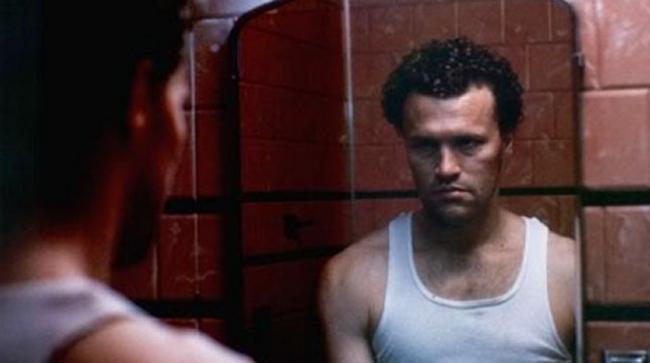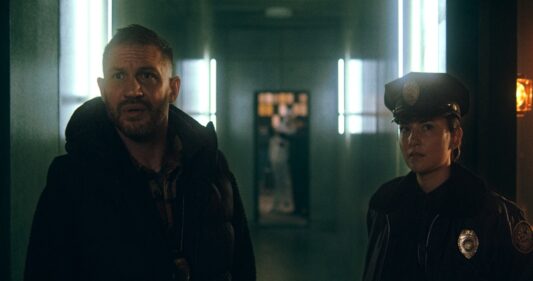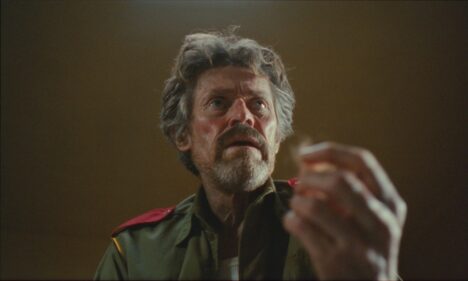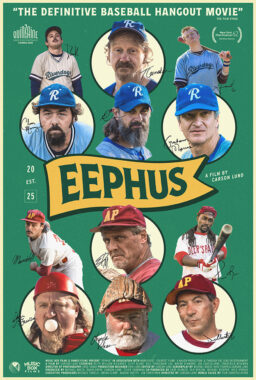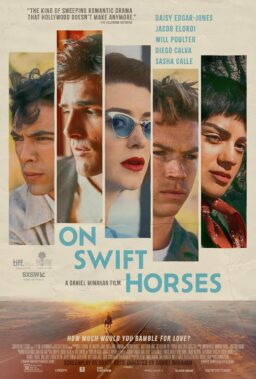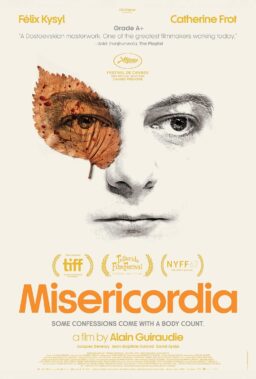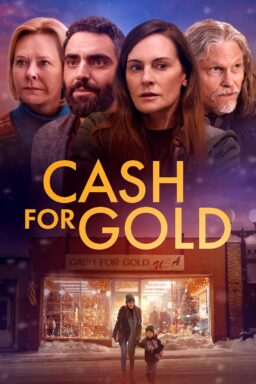When attendees of the 1986 Chicago International Film Festival arrived at the venerated Music Box Theatre one Saturday afternoon to see a horror film marking the feature directorial debut of a local documentarian and starring a cast of unknown actors, it is likely that they were attracted by the admittedly lurid title and settled into their seats expecting a typical gory genre film. It told the story, loosely based on a real-life case, of a serial killing drifter who introduces his new roommate to the process of brutally murdering random strangers—a move that becomes complicated both by the arrival of the roommate’s sister and the zeal with which the roommate takes to killing people. The difference between this film and countless other films of its type was that this was a horror film that took things seriously and refused to give viewers an easy out in regards to what they were seeing by including quippy dialogue, cartoonish levels of gore or any sort of story element that would suggest that things might turn out all right in the end. At a time when the genre was overrun with endless “Friday the 13th” and “Nightmare on Elm Street” sequels, this was one that genuinely shook viewers with its unsparingly bleak vision but which also rewarded them with incredibly self-assured direction and a central performance that was simply unforgettable.
That film, of course, was “Henry: Portrait of a Serial Killer,” which marked the feature debuts of director John McNaughton and star Michael Rooker. After that screening, the film went into limbo for the next few years because of distribution problems relating to the MPAA slapping it with a commercially deadly “X” rating (and advised McNaughton that there was no possible way that it could be cut down to an “R”) but thanks to the sub rosa spread of videocassettes, the film slowly developed a cult following that eventually hit the mainstream when the film was finally given a theatrical release in 1990. Although not a huge financial success in theaters, it received rave reviews from many influential critics and when it hit home video—the market for which it was initially designed—horror fans began recommending it to other buffs as being the real thing. As for McNaughton and Rooker, they would both use the film as a springboard for careers in Hollywood—the former as the director of such films as “The Borrower” (1991), “Mad Dog & Glory” (1993), “Wild Things” (1998), “The Harvest” (2015) and “A Normal Life,” a 1996 true crime story with Ashley Judd and Luke Perry that is one of the best films of the last couple of decades that you have never heard of and the latter would turn up in such films as “J.F.K.” (1991), “Cliffhanger” (1993), “Mallrats” (1995), “Slither” (2006) and “Guardians of the Galaxy” (2014).
Thirty years later, McNaughton and Rooker have returned to the scene of the crime, the Chicago International Film Festival, to help present, in a slightly more ideal time slot, an anniversary screening of a new 4K transfer of “Henry: Portrait of a Serial Killer,” which may look better than it has in a long time but which has not lost a single bit of its ability to shock and unnerve even the hardiest of viewers. The film is also being given a 20-city theatrical release this Friday, including in the place where it all began, the Music Box. Before the screening, the two sat down with me for a long and jovial conversation about the history of the film, the original premiere, the shooting of the most notorious of all its scenes and even offer an impromptu pitch for a “Henry” TV series for good measure.
Considering that “Henry: Portrait of a Serial Killer” has become a classic in the annals of horror film history, did either of you have any particular affinity for the genre when you were growing up and if so, which were the films that grabbed you?
ROOKER: “Night of the Living Dead” is one of my favorites. I had seen other ones earlier but that is one of my favorites—George Romero’s “Night of the Living Dead.”
MCNAUGHTON: Horror was not my first love. Film noir, perhaps. Anything dark or set at night. Anything that came out of the New York school of social realism. Anything that had method acting out of the Strasberg school. All that New York-based American drama. First and foremost—anything by Tennessee Williams, even though I didn’t know who he was. You know “The Fugitive Kind”? When I was a kid, that movie blew me away. There was some horror. Growing up in the late 60s, when I went to art school instead of film school, the artist’s main rule was to see where the boundary was for good taste and step over it and break that boundary. So there was a series of horror films back then, when people listened to radio all the time, and they would come out with these incredibly lurid radio commercials that would play all day, every day. There was a series of horror films that included “Last House on the Left” that always pushed things to a new level in regards to breaking the taboos of horror and violence and blood. I sort of saw us as being in that lineage of breaking the boundaries—we were going to have to do that if we were going to get our film noticed.

What is fascinating about “Henry” is that even after 30 years, it still has the power to shock and horrify viewers. Most horror films, no matter how good they are, tend to lose that ability over time because of things ranging from societal changes to the films themselves being reduced thanks to endless sequels, ripoffs, spoofs and remakes. A film like “The Exorcist” freaked people out but when it came out 40 years down the line, it just cannot have the same impact because it has been spoofed, sexualized and even turned into a TV series.
ROOKER: Well, we haven’t gone on “Saturday Night Live” and spoofed it yet.
MCNAUGHTON: Maybe if someone offers us enough to do a series, we could make some real dough. You know, Michael and I liked to drive—I don’t know if he still does this—and I used to drive back and forth between Chicago and Los Angeles for jobs. I loved the highway, though now it is like solid construction—the joy of the road is gone. I used to work with a traveling carnival and you live in trucks and go jumping from town to town on the interstates and those big truck stops are cities unto themselves with a culture of truck drivers that is different from everything else. You have your big rig and your sleeper and they don’t turn those trucks off—in the summer, they keep the AC running and in the winter, they keep the heat running. Those truck stops are worked by prostitutes and drug dealers and a lot of prostitutes get picked up and disappear. There is a real epidemic of truck driving serial killers out on the American highways. I had the idea for Michael—boom, we never even have to say the character’s name—driving a big rig. Maybe he picks up and gets to know a younger man who is a ne-er-do-well and teaches him how to kill.
Sort of a mentoring thing.
ROOKER: I’ve always wanted to play a teacher.
The film was inspired at least in part by the rumored exploits of real-life serial killer Henry Lee Lucas, who at one point had claimed to have killed hundreds of people. When you first began, were you just looking at serial killers in general before coming across his case or did the inspiration come after hearing about him?
MCNAUGHTON: As often happens in life, opportunity presents itself by destiny. I went in for a meeting with Waleed Ali, who is now deceased and for whom I had done this documentary called “Dealers in Death,” which was about Chicago gangsters and narrated by Broderick Crawford and made mostly from public domain photographs and footage that we didn’t have to pay for. We went into the marketplace because that was in the early days of VHS and that was the business that the Ali brothers were in. We all made a little bit of money. I had gone in to see Waleed about doing another documentary and something happened—some confusion and a switching of monies asked for—so they decided not to do it. On that particular day, Waleed said “Remember that dream we had, John, that we would one day make a movie? I’ll give you $100,000 to make a horror film.” because they could sell a horror film at that time.
I left the office and down the hall was an old friend of mine who was always into weird stuff and who had an office there—he collected weird stuff for them and they would figure out how to make money off of it. I said “Gus, Waleed just gave me $100,000 to make a horror film.” He asked what I was going to do and I told him I had no idea. He goes “Here, watch this” and he took a cassette and put it in the machine and it was the newsmagazine “20/20” doing a 20-minute segment on Henry Lee Lucas. It was the first time I heard the phrase “serial killer”—I was always a true crime fan but I found out later that the term “serial killer’ was coined by the FBI only about two years earlier.
Certain things are destiny, like when he [pointing at Michael] showed up at the door for his first audition—I opened the door and thought “Henry’s here.” It was not a process of sifting through ideas and going through things that I had thought of over the years. When I left the building that day, there was a 7-11 down the street and I went there and bought some lottery tickets because I figured this was my lucky day.
When you turned up at that audition, what was it about the script and the character that spoke to you and convinced you that you could play that part?
ROOKER: I don’t think I had read the script right away. I went to the audition and got some audition materials and did that. When did I end up getting the full script?
MCNAUGHTON: It has been 30 years but I assume that we probably hadn’t finished the script at that point.
ROOKER: It was still a work-in-progress. It was almost as if we workshopped it a little bit and started coming up with ideas and different things. We did our bios and all that kind of stuff.
MCNAUGHTON: We had two weeks of rehearsal and they had all come out of theatre and knew how to rehearse, unlike a lot of actors who have no theatre background and have no idea of what to do when you rehearse.

The visual style for the film is very interesting. On the one hand, it definitely has a gritty, documentary-like feel to it but at the same time, there is very little camera movement to be had.
MCNAUGHTON: Once again, coincidence played a big part in that. I was going to hire a guy that I knew from graduate school to shoot it—a skinny Frenchman who came over here when he was five years old and who was perhaps the greatest hand-held cameraman in America and maybe beyond. When he had the camera on his shoulder, he could make moves that looked like they were done with cranes—he did not shake. It had that fluidity of movement without any jitter. Anyway, I hired him to shoot the film and it would have been 100% handheld because we were trying to create this realism of real being there. He was pre-booked to do this documentary in Spain and as it turned out—and this is something that never happens—his documentary was pushed not forward but two weeks backward, which would have been right in the middle of our schedule. We would have had him for two weeks and then we would have to replace him. Steve Jones, who was the producer and who worked in advertising, and I saw some guys and we chose Charlie Lieberman, who also came out of commercials but was not a handheld cameraman. We got this dolly that was like a piece of plywood with four tires on it to use for the whole show for $300. Charlie had his own 16mm Arriflex, which was perfectly maintained because Charlie shot commercials, and a tripod. We didn’t have a standard good dolly.
ROOKER: I remember them putting styrofoam over the lightbulbs to tweak the lighting because we only had three people.
MCNAUGHTON: We had a sound guy who did both the boom work and wore the Nagra recorder on a strap and did the modulation at the same time. There was no looping on that film because the tracks were great.
The most infamous scene in the film is the home invasion sequence in which Henry and Otis kill an entire family and are then later seen cooly watching a videotaped replay of their crime. Can you guys talk a little about what went into conceiving and executing that particular scene?
ROOKER: The staging of the scene and the acting of the scene blended together in that one. There were mirrors all in that room. . .
MCNAUGHTON: Waleed had bought that house and I don’t know who had been there before, but they had terrible taste. He was going to redo the house but it was this big suburban house out in wherever it was. It didn’t matter if we splattered blood all over because it was his house and he was going to repaint it and everything else.
ROOKER: It had all these mirrors and we had an issue with trying to do the scene without having the cameraman being reflected. I just finally said that I would just do it. His camera is his baby, so he was like “Uhhhhhhhhhh. . . “ I said “Look, I have been doing photography since high school—I know how to operate a camera.” It ended up being a great move because at that time, I would shoot Otis and then I would pan over and see the kid come through the door and then I would drop the camera. When I did that, it would go away from the mirror and Charlie took it and placed it so that I would run past it. It was a nice little dance that ended up being a great scene.
MCNAUGHTON: We shot two takes and after the second take, which is the one that plays, I just turned and said “None of us are going to Heaven after shooting this.”
ROOKER: The second time was the take and I grabbed the kid and threw him down and he landed exactly in the right position to be seen on camera—the first time, he was a little off and I had to jerk him into the frame. The second one, he was right there and he fought me hard that second time—I told him “Dude, don’t let me do shit. You are going to have to fight me.” We were going at it there and it was a great sequence.

Having been given the money by him to go off and do a horror film, what was the reaction from Waleed when he first saw what he was getting in return? I suspect it was like that part in “The Producers” when they cut to the reaction of the opening night crowd at the conclusion of the “Springtime for Hitler” number.
MCNAUGHTON: In their defense, what they saw was not anything close to the final film. We shot 16mm and back in those days, we rented a flatbed 16mm cutting machine and installed it in Elena Maganini’s apartment —she worked her day job and would edit at night and weekends until she went half-crazy. Elena, who was my editor for 25 years, didn’t have a child until later in life and she is very maternal, so the films we made together were her kids and you do not touch a hair on the heads of her little ones. The first cut was 2:20 and it is now an 83-minute film. She had cut commercials for years but none of us had ever worked at making a full-length dramatic feature film. Not only was it two hours and twenty minutes long, the company that made it was a video distribution company and there was never going to be a film print. Once we got the cut negative transferred to video, that would be the print master to create videocassettes. The way that we presented it to them—that video camera that the boys used in the film? That was a real camera and when they threw it out the window, we bought a dummy for $45 that was just a shell because we bought the real camera for $900 and that was almost 1% of the budget. We mounted it on a tripod, aimed it at the flatbed screen, which was not of particularly high quality and had only one crappy speaker, and we recorded the movie. That is what we showed them because that was all we had. I have to say, our relationship has never been the same since then and I learned an incredibly important lesson. Some months later, when we had a 16mm print that was properly timed, it looked like what you will see tonight but it didn’t matter because all they remembered was the 2:20 black-and-white flickered version.
The film had its world premiere 30 years ago at the 1986 Chicago International Film Festival. What do you recall about the experience of unleashing the film on an unsuspecting audience for the first time?
ROOKER: It was my very first time seeing it too—at the Music Box, right?
MCNAUGHTON: They had a program within the program called “Illinois Filmmakers”—who to this day are considered to be third-class human beings in this international film festival—and they gave us 2:30 PM on a Saturday at the Music Box. Again, we didn’t have a film print—we had a ¾-inch videocassette—two of them because one cassette only ran for an hour. We had to find a projector so we went to this equipment rental joint and got a projector. Michael and I took it to the Music Box and it was big. It cost $175 and I don’t know who paid it because I don’t think either of us had $175 in those days. We weren’t techs but it had to be set up and focused and adjusted, so we did it. We got it all lined up and when the crowd got there, we turned it on and it had to be changed out after one hour. Always in those days, we lost a few audience members at the home invasion scene. I am curious tonight because we just resubmitted to the MPAA and we got an X again. I have family members coming who have never seen it and they are not people who see this kind of movie, so I am wondering how they are going to react.
Tonight at the screening will be the woman who was {co-writer} Richard Fire’s wife when we made the movie, Wendy Sanders. Wendy is a really lovely person and when we were writing the script, she would be there making snacks and coffee. She came from a lefty family in Chicago and was very liberal and very sweet. When she saw it for the first time, at the end, she saw the suitcase and was about to cry. She looked up at us and she goes “Where’s Becky?”
ROOKER: I regret to this day that I did not keep that suitcase.
MCNAUGHTON: TCM is having these big auctions with Sotheby’s for memorabilia, though something tells me that they would balk at that suitcase.

Michael, although it would be another four years before “Henry” would finally receive commercial distribution, thanks in part to a long battle with the MPAA, who slapped it with an X rating, you were already becoming a familiar face in Hollywood by that time with performances in films like “Eight Men Out,” “Mississippi Burning” and “Sea of Love.” Was this based off of people out there having gotten a chance to see the movie even though it had not yet been formally released?
ROOKER: People had seen it. As a matter of fact, I had done all those movies you just mentioned but the first time I ever got recognized in public was on Ventura Boulevard in a car. The guy in the car next to me kept following me and looking at me. I was thinking that I’m a Chicago guy and that I might have to get out of my car and take care of this guy—that is just the way I am thinking. He comes up and rolls his window down and I roll my window down and I’m going “Yeah?” He goes “Henry Lee Lucas!” When he was rolling down his window, I saw that he was smiling a little bit so I wasn’t feeling a threat so I was thinking “Eight Men Out” or something. No, it was “Henry”—he had seen “Henry.” I questioned him—“Dude, where did you see that? It isn’t even out yet.”—and he said that he worked somewhere and it turned up in the mailroom and he saw it and passed it off to his friends.
MCNAUGHTON: MPI was a video distribution company with a very high-quality lab. The publicist was Chuck Parello and I would call him and tell him to send one to Dave Kehr or here or there in L.A. They sent out hundreds and they all had babies.
ROOKER: That was how the fan base grew and grew. I like to say that it was an absolute, pure and simple grassroots PR campaign, whether they knew it or not, that developed into this undercover fan base that ended up being great for the movie.
We were joking earlier about a “Henry” TV series but there was, in fact, a “Henry” sequel produced that neither of you were involved with. Were either of you approached to either do that particular film or to do an actual sequel of your own?
MCNAUGHTON: Not to me. The guy who made the sequel was the guy who was the publicist on the first one—he was their publicist and he had been my assistant. That was just a deal between them. I think Michael may have come in for a while but that didn’t work out.
ROOKER: I went in for like five seconds. It was just a different vibe, a different energy and it just didn’t happen.
When you guys watch the film today, what goes through your mind as you see it now?
MCNAUGHTON: The little details—the things that you had completely forgotten. When Michael showed up for his first audition, he was Henry. He had the jacket, the blue chamois shirt, the blue workpants—I think we changed his shoes and that was it. He came as Henry. We didn’t have any money so when you watch the movie, watch how before he kills anybody, he takes off his jacket because we only had one.
ROOKER: We only had the one jacket and I used it for work and I couldn’t get it bloody.
MCNAUGHTON: He had to somehow make it look convincing that he was taking it off for some real motivated reason.
ROOKER: But it worked because I am from the South and when anyone is about to fight, you take shit off. My cousins fight with no shirts on—they would rip it off and throw it in the guy’s face. That is what they did and so I was thinking that, as opposed to not getting the jacket dirty. The reality was that I couldn’t get the jacket dirty and that is what motivated it. I still have that jacket—I should have brought it with me tonight.

